Diseases
Vitamin A and xerophthalmia

Definition
Xerophthalmia is dryness of the ocular surface. Vitamin A deficiency is one of the major causes worldwide. Left untreated, it can be painful at best, blindness at worst.
Vitamin A, stored in the liver, is essential for many of the body's biological functions, including the proper functioning of the cornea's light-sensitive nerve cells.
Vitamin A deficiency mainly affects children, particularly the malnourished. Vitamin A intake must also be monitored in people with eating disorders.
To compensate, vitamin supplements should be taken in high doses over a few days. Thereafter, it is important to ensure a sufficient intake of vitamin A through the diet, bearing in mind that beta-carotenoids, notably found in fruit and vegetables, are converted into vitamin A by the body.
Causes
Vitamin A deficiency is responsible for the onset of xerophthalmia. More broadly, this deficiency also affects the skin and tissues and, by degrading the immune system, favors the development of infections.
It is directly linked to malnutrition. Firstly, because vitamin A is provided by the diet (it is present in meat, liver, butter, whole milk, cream and eggs, but also, in the form of beta-carotenes, in sweet potatoes, carrots, pumpkins, apricots, mangoes, melons, spinach and broccoli), it is insufficient in cases of malnutrition. Secondly, because vitamin A is stored in the liver and fatty tissue (known as adipose tissue), it is fat-soluble, meaning it needs fat to be properly assimilated by the body.
With too little fat, vitamin A is less well utilized by the body, as are all the other fat-soluble vitamins (D, E and K).
Certain illnesses, such as chronic diarrhoea or disorders of the pancreas or intestine, can also prevent the body from absorbing this vitamin properly. Liver disorders can also have a negative effect, leading to deficiency.
Vitamin A and beta-carotene (also known as pro-vitamin A, since the body converts it into vitamin A; it gives fruits and vegetables their color) are very important for the proper functioning of eye cells.
Symptoms
The first symptom of xerophthalmia is night blindness.
Deposits, known as Bitot spots, sometimes appear in the white of the eye.
Symptoms range from photophobia, which can be extremely debilitating and painful in the case of corneal ulceration, to keratomalacia, a softening of the cornea, causing it to lose its optical power. The remodelling and loss of protection of the cornea's first layer favours the emergence of superinfections, or even perforation or tumour transformation.
Xerophthalmia progresses slowly but inevitably to blindness if vitamin A deficiency is not corrected.
Diagnosis
Clinical and slit-lamp examinations should be carried out if xerophthalmia is suspected. A blood test may or may not confirm the presence of vitamin A deficiency, which may explain the onset of the disease.
In some cases, electroretinography - an electrical analysis of the activity of retinal cells, which themselves consume vitamin A - is required to determine whether difficulties in seeing in the dark are due to vitamin deficiency.
Diagnosis is rarely early. It is often made after the onset of the first symptoms, usually night blindness, when vitamin deficiency is unfortunately already well established.
Treatment
As soon as deficiency is confirmed, high doses of vitamin A should be taken orally over several days. Dosages can then be reduced until symptoms improve and disappear.
Caution is advised with babies, however, for whom prolonged high doses of vitamin A can become toxic. Breast-fed children under six months have a very low risk of vitamin A deficiency.
Eye drops and ointments can also be used to protect the cornea. But treating the cause quickly, and therefore taking vitamin A, remains the most effective solution.
In terms of prevention, a diet rich in colorful vegetables and fruit can help reduce the risk of vitamin A deficiency and hence xerophthalmia.
References
- https://medicalguidelines.msf.org/fr/viewport/CG/francais/xerophtalmie-carence-en-vitamine-a-16689720.html
- https://afpa.org/content/uploads/2017/10/vitamine_a_miseaupoint.pdf
- https://www.larousse.fr/encyclopedie/medical/x%C3%A9rophtalmie/17059
content reviewed and controlled on 16.01.2025
